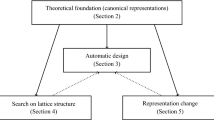Abstract
This paper addresses the issue of building a part-based representation of a dataset of images. More precisely, we look for a non-negative, sparse decomposition of the images on a reduced set of atoms, in order to unveil a morphological and interpretable structure of the data. Additionally, we want this decomposition to be computed online for any new sample that is not part of the initial dataset. Therefore, our solution relies on a sparse, non-negative auto-encoder where the encoder is deep (for accuracy) and the decoder shallow (for interpretability). This method compares favorably to the state-of-the-art online methods on two datasets (MNIST and Fashion MNIST), according to classical metrics and to a new one we introduce, based on the invariance of the representation to morphological dilation.
Access this chapter
Tax calculation will be finalised at checkout
Purchases are for personal use only
Similar content being viewed by others
Notes
- 1.
For code release, visit https://gitlab.telecom-paristech.fr/images-public/asymae_morpho.
References
Angulo, J., Velasco-Forero, S.: Sparse mathematical morphology using non-negative matrix factorization. In: Soille, P., Pesaresi, M., Ouzounis, G.K. (eds.) ISMM 2011. LNCS, vol. 6671, pp. 1–12. Springer, Heidelberg (2011). https://doi.org/10.1007/978-3-642-21569-8_1
Ayinde, B.O., Zurada, J.M.: Deep learning of constrained autoencoders for enhanced understanding of data. CoRR abs/1802.00003 (2018)
Charisopoulos, V., Maragos, P.: Morphological perceptrons: geometry and training algorithms. In: International Symposium on Mathematical Morphology and Its Applications to Signal and Image Processing, pp. 3–15, April 2017. https://doi.org/10.1007/978-3-319-57240-6_1
Chen, X., Duan, Y., Houthooft, R., Schulman, J., Sutskever, I., Abbeel, P.: InfoGAN: interpretable representation learning by information maximizing generative adversarial nets. CoRR abs/1606.03657 (2016)
Dosovitskiy, A., Springenberg, J.T., Brox, T.: Learning to generate chairs with convolutional neural networks. CoRR abs/1411.5928 (2014)
Hosseini-Asl, E., Zurada, J.M., Nasraoui, O.: Deep learning of part-based representation of data using sparse autoencoders with nonnegativity constraints. IEEE Trans. Neural Networks Learn. Syst. 27(12), 2486–2498 (2016)
Hoyer, P.O.: Non-negative matrix factorization with sparseness constraints. CoRR cs.LG/0408058 (2004)
Ioffe, S., Szegedy, C.: Batch normalization: accelerating deep network training by reducing internal covariate shift. CoRR abs/1502.03167 (2015)
LeCun, Y., Cortes, C.: MNIST handwritten digit database (2010). http://yann.lecun.com/exdb/mnist/
Lee, H., Ekanadham, C., Ng, A.Y.: Sparse deep belief net model for visual area V2. In: Platt, J.C., Koller, D., Singer, Y., Roweis, S.T. (eds.) Advances in Neural Information Processing Systems 20, pp. 873–880 (2008)
Lemme, A., Reinhart, R.F., Steil, J.J.: Online learning and generalization of parts-based image representations by non-negative sparse autoencoders. Neural Networks 33, 194–203 (2012)
Maas, A.L.: Rectifier nonlinearities improve neural network acoustic models. In: International Conference on Machine Learning (2013)
Mairal, J., Bach, F.R., Ponce, J.: Sparse modeling for image and vision processing. CoRR abs/1411.3230 (2014)
Maragos, P., Schafer, R.: Morphological skeleton representation and coding of binary images. IEEE Trans. Acoust. Speech Sig. Process. 34(5), 1228–1244 (1986)
Pesaresi, M., Benediktsson, J.A.: A new approach for the morphological segmentation of high-resolution satellite imagery. IEEE Trans. Geosci. Remote Sens. 39(2), 309–320 (2001)
Ritter, G., Sussner, P.: An introduction to morphological neural networks. In: 13th International Conference on Pattern Recognition, vol. 4, pp. 709–717, September 1996. https://doi.org/10.1109/ICPR.1996.547657
Soille, P.: Morphological Image Analysis: Principles and Applications. Springer Science & Business Media, Heidelberg (2013)
Tanaka, K.: Columns for complex visual object features in the inferotemporal cortex: clustering of cells with similar but slightly different stimulus selectivities. Cereb. Cortex 13(1), 90–9 (2003)
Theis, F.J., Stadlthanner, K., Tanaka, T.: First results on uniqueness of sparse non-negative matrix factorization. In: 13th IEEE European Signal Processing Conference, pp. 1–4 (2005)
Velasco-Forero, S., Angulo, J.: Non-Negative Sparse Mathematical Morphology, chap. 1. In: Advances in Imaging and Electron Physics, vol. 202. Elsevier Inc., Academic Press (2017)
Xiao, H., Rasul, K., Vollgraf, R.: Fashion-MNIST: a novel image dataset for benchmarking machine learning algorithms. arXiv:1708.07747 (2017)
Zhang, L., Lu, Y.: Comparison of auto-encoders with different sparsity regularizers. In: International Joint Conference on Neural Networks (IJCNN), pp. 1–5 (2015)
Acknowledgments
This work was partially funded by a grant from Institut Mines-Telecom and MINES ParisTech.
Author information
Authors and Affiliations
Corresponding author
Editor information
Editors and Affiliations
Rights and permissions
Copyright information
© 2019 Springer Nature Switzerland AG
About this paper
Cite this paper
Ponchon, B., Velasco-Forero, S., Blusseau, S., Angulo, J., Bloch, I. (2019). Part-Based Approximations for Morphological Operators Using Asymmetric Auto-encoders. In: Burgeth, B., Kleefeld, A., Naegel, B., Passat, N., Perret, B. (eds) Mathematical Morphology and Its Applications to Signal and Image Processing. ISMM 2019. Lecture Notes in Computer Science(), vol 11564. Springer, Cham. https://doi.org/10.1007/978-3-030-20867-7_25
Download citation
DOI: https://doi.org/10.1007/978-3-030-20867-7_25
Published:
Publisher Name: Springer, Cham
Print ISBN: 978-3-030-20866-0
Online ISBN: 978-3-030-20867-7
eBook Packages: Computer ScienceComputer Science (R0)




